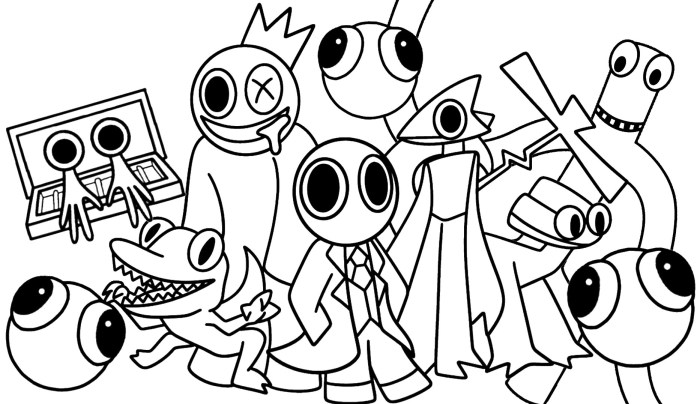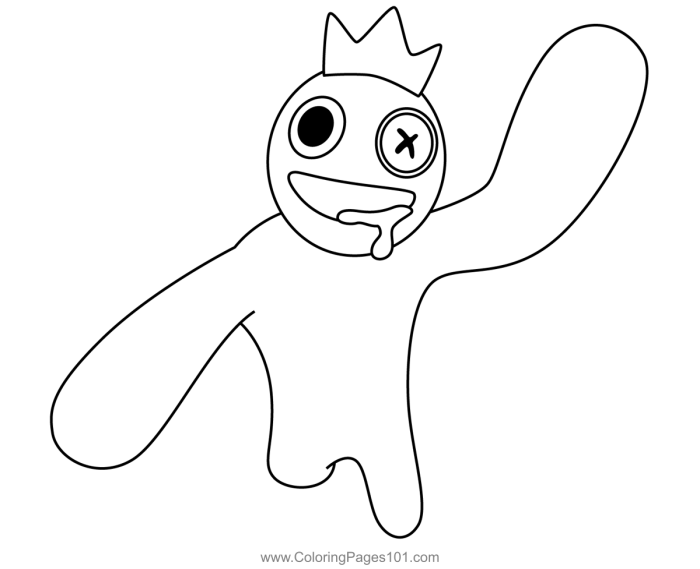Market Research

Coloring book rainbow friends – This section analyzes the market demand for a Rainbow Friends coloring book, examining its potential success within the broader children’s coloring book market. The analysis considers market size, competitor analysis, target audience demographics, and derives implications for product development and marketing strategies. Accurate data on the specific market size for Rainbow Friends coloring books is currently unavailable due to the novelty of the IP.
The vibrant hues and playful characters of “Coloring Book Rainbow Friends” offer a delightful creative outlet for children. This focus on bright, engaging imagery contrasts with the gentler, more subdued tones sometimes found in other coloring books, such as the bonding buds coloring book , which emphasizes friendship and connection. However, both types of coloring books share the common goal of fostering creativity and providing a relaxing, enjoyable activity.
Ultimately, “Coloring Book Rainbow Friends” stands out for its bold aesthetic and imaginative characters.
However, we can extrapolate from broader market trends and comparable licensed properties.
Current Market Size and Trends for Children’s Coloring Books Featuring Popular Characters
The children’s coloring book market is a significant sector within the broader publishing industry. While precise figures fluctuate yearly, the market consistently demonstrates robust sales, driven by parental interest in creative activities for children and the enduring appeal of coloring books as a low-cost, engaging entertainment option. Trends indicate a growing preference for coloring books featuring licensed characters from popular movies, television shows, video games, and online content.
This trend leverages the pre-existing brand recognition and fan bases of these characters to boost sales. Market growth is also influenced by the introduction of innovative formats, such as augmented reality coloring books and coloring books with interactive elements.
Comparison of Rainbow Friends Popularity with Other Similar Licensed Characters
Rainbow Friends, a horror-themed multiplayer game, has cultivated a substantial online following, particularly amongst younger audiences. Its popularity is comparable to other internet-born properties that have successfully transitioned into merchandise, such as Among Us or Roblox characters. However, direct market share comparisons with established licensed characters in the coloring book market (e.g., Disney princesses, Marvel superheroes) are challenging due to a lack of readily available sales data for Rainbow Friends merchandise.
A key differentiator for Rainbow Friends is its darker, more suspenseful aesthetic, which presents both an opportunity and a challenge. While this may appeal to a specific niche, it might limit the broader appeal compared to more universally accessible characters.
Target Audience Demographics for Rainbow Friends Coloring Books, Coloring book rainbow friends
The primary target audience for a Rainbow Friends coloring book would be children aged 6-12 years old, with a potential secondary market extending to older teenagers and young adults who are fans of the game. While the game itself may have a broader gender appeal, initial marketing research suggests a slightly higher interest among boys. The target audience’s interests extend beyond just the game itself, encompassing creative activities, horror-themed media (within appropriate age ranges), and gaming culture in general.
Further research into specific age group preferences within this demographic is needed to optimize coloring book content and marketing.
Key Findings Summary
| Metric | Value | Source | Implications |
|---|---|---|---|
| Market Size (Children’s Coloring Books) | Significant and growing; precise figures vary annually | Industry reports, market analysis databases | Large potential market; requires focused targeting within the niche |
| Rainbow Friends Popularity | Substantial online following, comparable to other successful internet-born IPs | Social media analytics, game downloads/streaming data | Strong potential for success, but requires careful market positioning |
| Target Audience Age | Primarily 6-12 years old, with potential secondary market in older teens/young adults | Game player demographics, informal surveys (if conducted) | Content and marketing must cater to this age range and its interests |
| Target Audience Gender | Slightly higher interest among boys, but potential for broad appeal | Game player demographics, informal surveys (if conducted) | Marketing should consider gender-neutral approaches to maximize reach |
Design & Content

This section details the design and content specifications for a Rainbow Friends coloring book, focusing on page layout, character selection, coloring page concepts, and color palettes. A well-defined design and engaging content are crucial for creating a successful and appealing product. The choices made here directly impact the user experience and overall marketability.
Page Layout Specifications
The coloring book will utilize standard 8.5 x 11 inch (letter size) pages, allowing for optimal printing and handling. A 0.5-inch margin will be implemented on all sides of each page, providing ample space for binding and preventing coloring from bleeding into the margins. Images will be centrally positioned on each page, with the character(s) occupying approximately 60% of the page’s central area.
This ensures the main focus is on the Rainbow Friends characters while leaving sufficient space for creativity. Smaller details and background elements will fill the remaining space.
Rainbow Friends Character Selection
The inclusion of a diverse range of characters enhances the coloring book’s appeal. The following ten unique Rainbow Friends characters will be featured: Red, Orange, Yellow, Green, Blue, Indigo, Violet, a hybrid character combining elements of two colors (e.g., Orange-Yellow), a mischievous shadow character, and a friendly, glowing entity. Each character’s design will incorporate distinctive features, including varying body shapes, textures, and expressions, to create visual interest and cater to diverse preferences.
Coloring Page Concepts
Five distinct coloring page concepts will be developed to add variety and thematic depth. These themes will be:
- Underwater Adventure: Rainbow Friends characters exploring a vibrant coral reef, interacting with marine life.
- Playground Fun: Rainbow Friends enjoying various playground activities like slides, swings, and climbing frames.
- Spooky Forest: Rainbow Friends navigating a mysterious forest, encountering friendly woodland creatures and spooky shadows.
- Space Exploration: Rainbow Friends piloting spaceships and exploring different planets, encountering extraterrestrial life.
- Rainbow City: A bustling city populated by Rainbow Friends, showcasing diverse buildings and urban landscapes.
Each concept will be visually stimulating and provide opportunities for creative expression through coloring.
Color Palettes
The color palettes will be carefully chosen to enhance the visual appeal of each page and to complement the character designs. The primary color palette will utilize bright, saturated hues that are consistent with the Rainbow Friends aesthetic. However, subtle variations will be introduced to create visual depth and contrast. For example, the “Spooky Forest” page will incorporate darker shades of green and purple to establish a mysterious atmosphere.
The “Underwater Adventure” page will use blues, greens, and yellows, with touches of brighter colors to mimic a vibrant underwater scene. The “Rainbow City” page will use a broader range of colors, reflective of a vibrant urban setting. This approach balances the familiar Rainbow Friends colors with thematic appropriateness.
Illustrations

The following specifications detail the visual elements required for a Rainbow Friends coloring book, aiming for a cohesive and engaging experience for the target audience. A balance between appealing character design and evocative backgrounds is crucial for success. The style should capture the essence of the Rainbow Friends while remaining suitable for coloring.
Rainbow Friends Character Descriptions
The success of the coloring book hinges on compelling character designs. Each character needs a unique visual identity that reflects their personality, making them instantly recognizable and memorable. The following descriptions provide detailed guidelines for illustrators.
- Red: A tall, slender figure with sharp, angular features. Its eyes are narrow and menacing, with a perpetual smirk. Its limbs are elongated and slightly distorted, conveying a sense of unease. The overall color palette should be primarily deep reds and crimson, with subtle shading to emphasize its sinister nature. Details like sharp teeth and claws should be subtly incorporated.
- Orange: A shorter, more rotund character compared to Red. Its features are softer, but still unsettling. It has large, round eyes that convey a sense of mischievousness, coupled with a wide, almost gummy smile. Its body is slightly misshapen, with disproportionate limbs. The color scheme should be bright oranges and yellows, contrasted with darker shades to hint at its underlying creepiness.
- Yellow: This character is characterized by its almost childlike features, but with a subtly disturbing undertone. It is smaller than Red and Orange, with large, innocent-looking eyes. However, the eyes should have a vacant, slightly unnerving quality. The mouth should be small and simple. The color palette should consist of bright, cheerful yellows and golds, but with muted tones to suggest a lurking darkness.
- Green: A lanky character with long, spindly limbs. Its features are less defined than the others, creating a more amorphous and unsettling appearance. It should have large, blank eyes that lack any expression. The color scheme should consist of various shades of green, ranging from bright lime to deep forest green, with some areas appearing almost translucent.
- Blue: This character should be depicted as the largest and most imposing of the group. It possesses a bulky, almost hulking physique, with heavy limbs and a slow, deliberate posture. Its face is largely obscured by shadows, with only glimpses of unsettling features visible. The color palette should be dominated by deep blues and purples, with heavy shading to enhance its menacing presence.
Background Scene Descriptions
The background scenes should complement the characters and enhance the overall mood of the coloring book. They should provide engaging visual elements without overpowering the characters.
- Abandoned Playground: A desolate playground with rusted swings, broken slides, and overgrown weeds. The overall tone should be dreary and slightly unsettling. Include details like cracked pavement, graffiti-covered walls, and scattered debris.
- Dark Forest: A dense, shadowy forest with tall, spindly trees and an oppressive atmosphere. The path should be barely visible, shrouded in darkness. Include details like gnarled branches, creeping vines, and ominous shadows.
- Haunted School: A dilapidated school building with broken windows, peeling paint, and overgrown vegetation. The interior should be dark and mysterious, with hints of previous activity visible, such as scattered books and overturned desks. Include details like cobwebs, dusty furniture, and eerie shadows.
Illustration Style
The most suitable illustration style for a Rainbow Friends coloring book is a stylized, slightly spooky aesthetic. The characters should be recognizable and engaging, but with a touch of darkness to reflect the overall tone of the franchise. The style should be detailed enough to be interesting to color but simple enough to be accessible to a wide range of ages and skill levels.
Think of a style that blends cute and creepy elements, similar to some modern cartoon animation styles with a slightly unsettling twist. Avoid overly realistic or overly simplistic styles. The lines should be clean and clear, allowing for easy coloring.
Query Resolution: Coloring Book Rainbow Friends
What age range is the coloring book designed for?
The target age range is typically 4-8 years old, aligning with the typical coloring book audience for this type of character.
What is the estimated production cost of the coloring book?
Production costs will vary based on print run size, paper quality, and printing method. A detailed cost analysis is needed to provide a precise estimate.
What are the key challenges in marketing a Rainbow Friends coloring book?
Key challenges include standing out in a competitive market, reaching the target audience effectively through appropriate channels, and managing the licensing agreements related to the Rainbow Friends characters.
What are the potential revenue streams beyond initial sales?
Potential revenue streams include licensing the design for other products, creating digital versions of the coloring book, and exploring international distribution.
